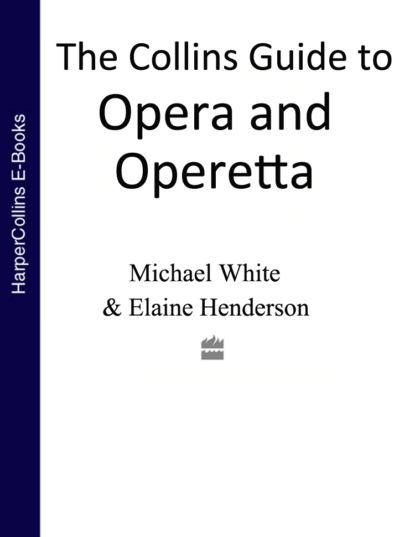По всем вопросам обращайтесь на: info@litportal.ru
(©) 2003-2024.
✖
The Collins Guide To Opera And Operetta
Автор
Год написания книги
2018
Настройки чтения
Размер шрифта
Высота строк
Поля
FIRST PERFORMANCE: Paris, 3 March 1875
Principal Characters
Carmen, a gypsy girl
Soprano
Don José, a corporal
Tenor
Micaëla, a country girl
Soprano
Zuniga, Don José’s lieutenant
Bass
Escamillo, a toreador
Baritone
Synopsis of the Plot
Setting: Seville, Spain; about 1820
ACT I In the square, dominated by a cigarette factory, a group of soldiers are lazily mounting guard when Micaëla arrives, looking for her soldier sweetheart, Don José, and is told to come back later. As Don José and Zuniga march in with the relief guard, the girls emerge from the factory for a break and Carmen is quickly surrounded by admirers. With her eye firmly fixed on José, she warns that loving her is a dangerous game and she tosses him a rose. When everyone has gone, José retrieves the rose and hides it in his tunic. Micaëla returns and is telling José news about his mother when José is informed that Carmen has attacked another girl, and he must arrest and guard her. Left alone with José, Carmen charms him into allowing her to escape.
ACT II Carmen is the centre of admiration at the local inn. Escamillo, the toreador, is particularly captivated by her, as is Zuniga. But when Carmen learns that José, who has been demoted and imprisoned for helping her, is about to be released, she warns them both to go away and not return. José arrives, delighted to be back with his beloved Carmen, who tries to persuade him to throw in his lot with some smugglers with whom she is working. José refuses, but when Zuniga returns and is attacked by Carmen’s new friends, he has no alternative but to escape with them.
ACT III In the smugglers’ hideaway Carmen and José are becoming increasingly disillusioned with each other. Escamillo comes looking for Carmen and José is forced to fight him. Micaëla, who has been searching for José, pleads with him to go with her to see his dying mother. José agrees, but he warns Carmen that the affair is not yet over.
ACT IV A grand bullfight is about to take place and Carmen enters triumphantly on Escamillo’s arm, ignoring warnings that José is in the crowd. Confronted by her rejected lover, she refuses to return to him and throws his ring in his face. Consumed by jealous rage, José stabs her to the heart before giving himself up.
Music and Background
Carmen is written in a form known as opéra comique, which means not that it’s a comedy but that it mixes song with spoken dialogue, and would have surprised audiences of its time in that it takes the otherwise straightforward ‘comique’ style to unprecedented levels of perfection and sophistication. Spain was an abiding obsession of French composers from the later 19th century onwards, and Carmen is saturated in local colour, with set-piece Spanish dances like the habanera and seguidilla. The orchestration is especially fine – it was praised by later composers like Tchaikovsky and Richard Strauss – and the emphasis on orchestral sound is the one vaguely understandable reason why contemporary critics thought of it as Wagnerian.
Highlights
Arguably every thirty bars! Act I has Carmen’s habanera ‘L’amour est un oiseau rebelle’ and seguidilla ‘Près des ramparts de Séville’. Act II introduces Escamillo with his bullish ‘Toréador, en garde’, and gives Don José his first real chance to shine with the Flower Song: ‘La fleur que tu m’avais jetée’. Act III has Carmen’s fatalistic foresight of death, ‘En vain pour éviter’, and Micaëla’s enchanting ‘Je dis que rien’, with a dramatic highlight in José’s ‘Dût-il m’en coûter la vie’. Act IV begins with the procession to the bull ring.
Did You Know?
The opera was a critical failure at its first performance but Tchaikovsky predicted that within ten years it would be the most popular opera in the world.
Oscar Hammerstein II turned the opera into an American wartime musical called Carmen Jones. Adapted for cinema in 1954, the title role was played by Dorothy Dandridge miming to the voice of Marilyn Horne.
Recommended Recording
Agnes Baltsa, José Carreras, Katia Ricciarelli, José van Dam, Berlin Philharmonic Orchestra/Herbert von Karajan. DG 410 088-2. A hard choice when there are so many alternatives – including Maria Callas (EMI), Marilyn Horne (DG) and Teresa Berganza (DG) – but this is a near-flawless cast, with Baltsa on devastating form, before the voice got raw.
Les Pêcheurs de Perles (#ulink_00dd8010-4ab4-5dc4-9caf-47180749cfd7)
(The Pearl Fishers)
FORM: Opera in three acts; in French
COMPOSER: Georges Bizet (1838–75)
LIBRETTO: M. Carré and E. Cormon
FIRST PERFORMANCE: Paris, 30 September 1863
Principal Characters
Leïla, a Brahman priestess
Soprano
Zurga, the fishermen’s leader
Baritone
Nadir, a fisherman
Tenor
Nourabad, a Brahman high priest
Bass
Synopsis of the Plot
Setting: Ceylon (Sri Lanka); ancient times
ACT I The fishermen have gathered on the beach to choose their new leader and to celebrate the occasion with singing and dancing. Zurga is chosen as their chief and, to his delight, his old friend Nadir arrives on the scene. Zurga and Nadir recall old times together, particularly their rivalry for the love of Leïla. They are pleased, however, that in spite of this, their sworn oath of friendship for each other has never been broken. A boat arrives, bringing with it a heavily-veiled priestess, who has come to undertake a vigil and to pray for the fishermen’s safety at sea. The priestess is sworn to strict vows of chastity, on pain of death, and Zurga forbids anyone to approach her. The priestess is, of course, Leïla, and she and Nadir recognise each other, rekindling their lost love.
ACT II Leïla and Nourabad are in a ruined temple and Nourabad reminds her of her vows. Leïla reassures him that she will not break her promises, reminding him of how she once risked death to protect a fugitive, whose gold chain she still wears. But when Nourabad leaves, she sings of her love for Nadir. In a moment he is beside her and they acknowledge their passion, before Leïla persuades Nadir to leave. Unfortunately he is seen by Nourabad and quickly captured. Leïla and Nadir are brought before Zurga who is inclined to be lenient – until he recognises Leïla and accuses Nadir of further treachery.
ACT III The storm outside echoes Zurga’s restlessness as he tries to decide what to do. Leïla begs him to pardon Nadir, but Zurga’s jealousy prevents him from doing so. Finally Leïla gives Zurga her gold chain and asks him to send it to her mother, after she is dead. The funeral pyre is ready and Leïla and Nadir are about to die, when someone sees the glow of fire in the distance – the camp is in flames! In the commotion Zurga admits that he set fire to the camp because Leïla saved his life once – it was he who gave her the chain long ago. Zurga releases Leïla and Nadir and they go, leaving him alone to face Nourabad, who has overheard everything, and the wrath of the people.
Music and Background
This is an opera that exists in varying editions made after Bizet’s death, and it isn’t hard to understand why the score fell prey to other hands. Its quality is uneven – Bizet called it an ‘honourable, brilliant failure’ – and there are longueurs that combine with a lamentably feeble plot to make the piece, in parts, almost unbearable. But there are also moments of luxuriant, Gounod-indebted melody that show the composer at his lyrical best. You just have to take the rough with the smooth.
Highlights









